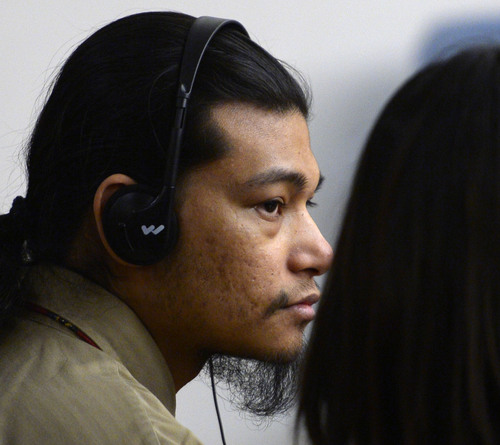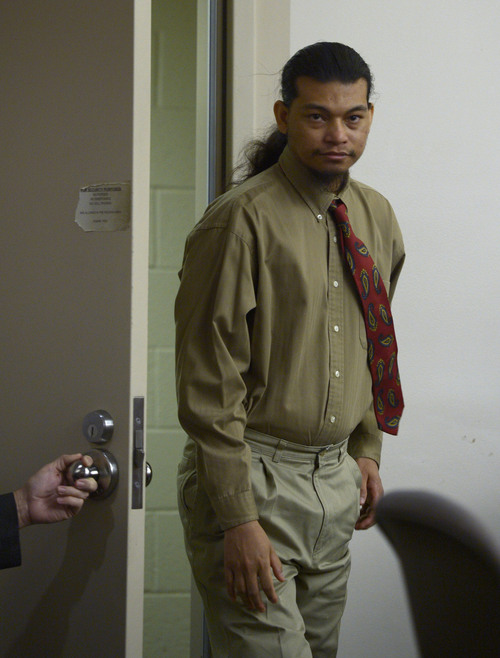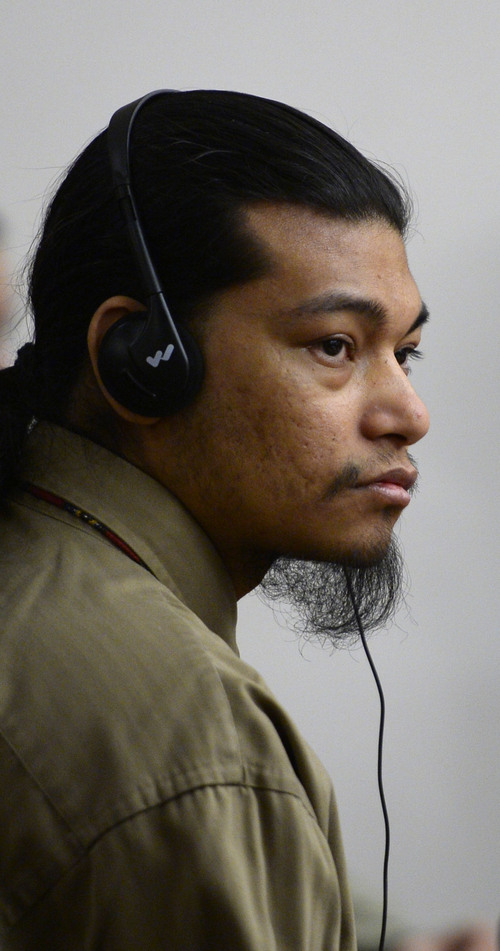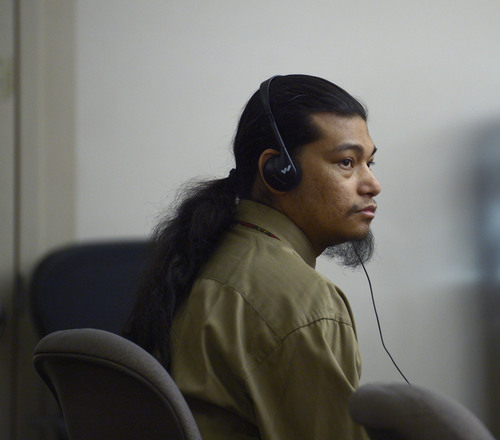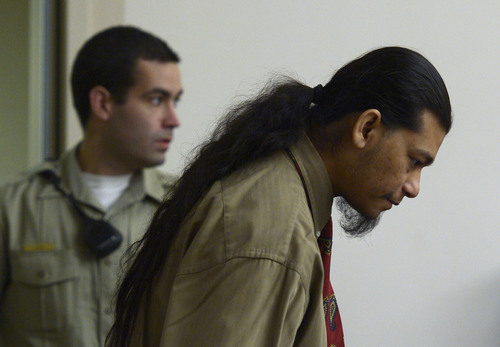This is an archived article that was published on sltrib.com in 2014, and information in the article may be outdated. It is provided only for personal research purposes and may not be reprinted.
Only one man knows where Esar Met was when a 7-year-old girl took her last breath.
Was he standing over her, as prosecutors have alleged, having brutally assaulted and slain Hser Ner Moo in the basement of his South Salt Lake home?
Or was he somewhere else, as defense attorneys have said? Gone to a bus, perhaps, attempting to navigate unfamiliar routes to the home of his aunt and uncle in Cottonwood Heights.
Only Met can answer these questions.
But on the eighth day of his trial, Met declined to testify in his own defense.
Speaking through a Burmese interpreter Thursday, Met invoked his right to remain silent, telling an 11-person jury he would not take the stand to answer to the charges against him: first-degree felony child kidnapping and aggravated murder.
Defense attorneys rested their case before 3rd District Judge Judith Atherton without calling a single witness.
The prosecution and defense will make their final arguments to the jury Friday morning.
If convicted, the 27-year-old man could spend the rest of his life in prison.
To reach a verdict, jurors will be asked to weigh gruesome crime-scene photographs, DNA evidence taken from the girl's fingernails and Met's denim jacket and the testimony of 41 witnesses who took the stand over the eight days of proceedings.
Hser Ner Moo disappeared from her family's home in the largely refugee community of South Parc on March 31, 2008, after spending the morning running and playing with her brother.
The next night, law enforcement officers found her: lifeless and bloody, lying facedown in the bathtub in the basement of a nearby apartment.
Her face was bruised a deep purple, with a scratch on her left temple just above her eye. The girl's left forearm, which was broken in two places, was unnaturally bent at a near-right angle. Scratches and marks lined her chest, her back and her neck.
A child abuse expert testified last week the injuries were among the worst she'd ever seen.
Although Met has not been charged accordingly, prosecutors allege he sexually assaulted the girl before killing her.
An examination of the child's genitals revealed internal wounds that Fraiser said hinted at "forceful penetration" that would have caused the girl excruciating pain.
An autopsy later revealed that despite the child's numerous injuries, it was a tear in the girl's heart that sealed her fate.
Met was arrested on April 1, 2008, at his aunt's home in Cottonwood Heights, where he had spent the day playing with his young cousins.
Those who knew him testified he was always surrounded by children.
"I've known him since we were [in refugee camps] together in Thailand," testified Maung Then Htank, the older brother of Hser Ner Moo's best childhood friend. "He loved kids. He was always playing with kids."
This access, prosecutors have said, gave him the opportunity to abduct and slaughter Hser Ner Moo.
But defense attorneys have argued that Met was gentle and caring with children, not the kind of man who would have killed the girl.
"He took care of us and loved us, just like little sisters," testified Hser Ner Moo's best friend Nane We.
Instead, the defense cast suspicion on Met's four roommates, who slept in bedrooms on the second floor of the shared South Parc apartment.
The roommates, who, like Met and Hser Ner Moo, are Burmese refugees, testified under oath on Tuesday that they had nothing to do with the child's disappearance or murder.
Their relationship with Met was cold — most didn't know his name at the time of his arrest, despite having lived with him for about a month. The men are of a different ethnic origin than Met and spoke different languages. Often, they wouldn't even stay in the same room.
Despite an increased police presence and large-scale community search for the missing girl, several roommates said they didn't realize the child was missing or thought to be in danger.
When police asked to search their home — Apartment 472 — in the evening hours of April 1, 2008, they granted them entry. They were watching a movie, the men said, and didn't realize something was wrong until officers loaded them into police cruisers and took them in for questioning.
"[Police] said Hser Ner Moo was gone, that Hser Ner Moo's body was found in our basement," roommate Maung Myo Mye testified through a Karen interpreter. "I was so surprised, I can't believe that was happening."
Prosecutors offered official time cards indicating all four roommates had been at work around the time Hser Ner Moo vanished.
Met, who was unable to immediately find work after arriving in the U.S. on Feb. 28, 2008, has no such proof of his whereabouts.
But Met, who bumped into his uncle on a bus that afternoon, would have had to leave the South Parc apartment complex where he lived no later than 2:39 p.m. to catch that bus, police said.
That means Met would have had to kill Hser Ner Moo during a window of about an hour between the time she vanished and the time he boarded a bus to his aunt and uncle's home in Cottonwood Heights.
On Wednesday, prosecutors wrapped up their case against Met with DNA evidence they said proves Met killed the girl.
Four small spots of blood on the defendant's dark jean jacket and microscopic samples of skin cells taken from under the slain girl's fingernails were tested for DNA in the murder's aftermath.
The blood, which dotted the back of Met's jacket, was determined to be Hser Ner Moo's.
DNA expert Chad Grundy testified there is little chance it belonged to anyone else — about 1 in 3.9 quadrillion.
But defense attorneys countered that the girl's blood on the back of Met's jacket proved little.
No blood was found on the garment's front or its sleeves, Grundy said. Met's pants and white T-shirt were clean.
The jacket, Met's family testified, was the only one he owned. He wore it all the time.
Defense attorneys suggested Met's clothing was stained well before Hser Ner Moo disappeared during a game the two often played, in which Met would pretend to be an elephant carrying the child and her friend atop his back.
They suggested she may have gotten a bloody nose or had a cut on her hand — which her family confirmed she did — that bled onto Met's coat.
The skin cells collected from under Hser Ner Moo's fingernails shared the same DNA profile as Met's, Sorenson Forensics DNA expert Daniel Hellwig testified, meaning the child had scratched Met sometime before her death.
Prosecutors pointed to this evidence as proof she fought back during an attack by the defendant — a theory they bolstered with testimony from Holli Barbera, a registered nurse who found small scratch marks on Met's legs that she said could have come from a child.
But Met's lawyers have said the skin cell evidence was also the result of such play wherein the girl may have accidentally scratched Met's skin. The scratch marks, defense attorneys offered, may have been from Met scratching himself or from police officer's rough take-down of Met at the time of his arrest. In cross examining Barbera, they indicated Met has struggled with a condition that causes his skin to dry out and itch.
Forensic evidence revealed that bloodstains found throughout Met's basement home belonged to Hser Ner Moo.
But it was a bloodstain of unknown origin that caused a stir in court Wednesday and prompted defense attorneys to motion for a mistrial.
A red stain found upstairs, where Met's four roommates lived, was tested on-scene in the days after the 2008 crime and found likely to be blood.
But Grundy, who works for the state crime lab, failed to take a sample of the blood to test for DNA that may have told investigators whose blood it was.
Grundy explained his logic Wednesday by saying he believed the "main crime scene" was in the basement where the majority of the blood evidence was found.
Though Met's attorneys eventually withdrew their motion for a mistrial — they said they could not prove the state withheld any evidence on purpose — they told the judge this previously overlooked evidence could have been what they needed to exonerate their client.
Prosecutors didn't know the stain was found likely to be blood until this week, when Grundy told them on Tuesday night. Until then, testimony indicated that all bloodstains in the apartment were found exclusively in the basement and the stairs that led down from the main floor.
If Hser Ner Moo's blood was found on the second floor, defense attorney Michael Peterson said, it could have been "potentially dramatically earth-shaking mitigating evidence" that showed the killer had been someone other than the defendant.
Twitter: @Marissa_Jae —
Esar Met timeline
March 31, 2008
• 1:30 to 2 p.m.: Hser Ner Moo last seen by her family.
• 2:39 p.m.: The latest Esar Met could have left his South Salt Lake apartment to catch a bus to Cottonwood Heights, where he stayed the night at the home of his aunt and uncle.
• 3:30 to 4 p.m.: Esar Met arrives at his aunt and uncle's home.
• 6:30 to 7 p.m.: Hser Ner Moo's father, Cartoon Wah, knocks on the door of Esar Met's apartment; Met's four roommates said they hadn't seen the girl.
• Evening: Hundreds of volunteers scour the area looking for the 7-year-old girl.
April 1, 2008:
• 4 a.m.: Detectives knock on the door of Apartment 472 , get no response.
• 7 p.m.: Hser Ner Moo's body found in Esar Met's basement apartment.
• 10 p.m.: Esar Met arrested at his aunt and uncle's home. —
A Missing Peace
Reporter Julia Lyon traveled to Thailand to trace the journeys of Hser Ner Moo and Esar Met from the Mae La refugee camp to Salt Lake City. Her series, reported in collaboration with the International Reporting Project, also explored the challenges their families and other refugees face in America. See the series at http://extras.sltrib.com/thailand.



